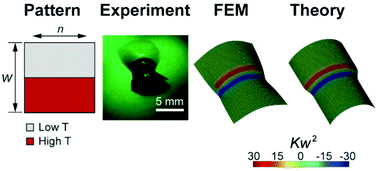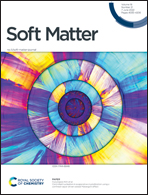Formation of rolls from liquid crystal elastomer bistrips†
Abstract
Formation of desired three-dimensional (3D) shapes from flat thin sheets with programmed non-uniform deformation profiles is an effective strategy to create functional 3D structures. Liquid crystal elastomers (LCEs) are of particular use in programmable shape morphing due to their ability to undergo large, reversible, and anisotropic deformation in response to a stimulus. Here we consider a rectangular monodomain LCE thin sheet divided into one high- and one low-temperature strip, which we dub a ‘bistrip’. Upon activation, a discontinuously patterned, anisotropic in-plane stretch profile is generated, and induces buckling of the bistrip into a rolled shape with a transitional bottle neck. Based on the non-Euclidean plate theory, we derive an analytical model to quantitatively capture the formation of the rolled shapes from a flat bistrip with finite thickness by minimizing the total elastic energy involving both stretching and bending energies. Using this analytical model, we identify the critical thickness at which the transition from the unbuckled to buckled configuration occurs. We further study the influence of the anisotropy of the stretch profile on the rolled shapes by first converting prescribed metric tensors with different anisotropy to a unified metric tensor embedded in a bistrip of modified geometry, and then investigating the effect of each parameter in this unified metric tensor on the rolled shapes. Our analysis sheds light on designing shape morphing of LCE thin sheets, and provides quantitative predictions on the 3D shapes that programmed LCE sheets can form upon activation for various applications.



 Please wait while we load your content...
Please wait while we load your content...
